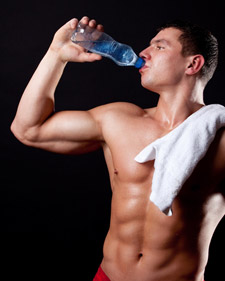Q&A with Mike Furci
04/22/2010
Furci Home / Fitness Channel / Bullz-Eye Home
 Mike,
Mike,
Long time reader here, who owes you a BIG thanks. I spent the last six months adopting your eating and training techniques: I am down 40 pounds and my weights in the gym have gone through the roof. I have passed your ideas on to my wife and a friend at work, and they also are doing great. I am looking to start incorporating creatine into my workouts and was looking for a recommendation on which brand to go with. Additionally, if you have any ideas to maximize its benefits I would love to hear them.
All the Best,
Mason

 Mason,
Mason,
Thanks so much for taking the time to read my articles and passing the info on.
Empirical and anecdotal data show creatine will work very well for about 30 to 40 percent of the people who use it. Another 30 percent of the people who use it will claim good results. But unfortunately, about 30 percent of all creatine users report almost no effect at all. Many of these people may be getting it in their diets from large amounts of red meat.
When taking creatine, use 20 grams per day for the first seven days as a loading phase. Do you need to load up? No, but your muscles will reach their saturation point quicker. After the loading phase, use 10 grams a day for five more weeks. Take the next three to four weeks off, and start again.
I also recommend consuming protein, in the form of whey isolate before and after training. The importance of pre- and post-workout nutrition cannot be overstated. On your workout days, put your creatine in your post-workout protein carb drink.
Creatine hit the market about 15 years ago and has been one of the top selling supplements since. Its popularity is due to one reason -- it works. Creatine works by giving the muscle cell what it needs to store adenosine triphosphate (ATP). ATP is the energy source our muscles use for heavy-duty, short-term workloads, the type used in weight training, sprinting, wrestling, etc. Increasing the amount of ATP production will pull more water into the muscle cells, which is how creatine produces its muscle cell volumizing effect.
As it turns out, creatine is much more than a “volumizing” agent. Canadian researchers compared the changes in the amount of in insulin-like growth factor-1 (IGF-1) in two groups of subjects. All the subjects performed at least 30 minutes of structured physical activity three to five times per week for eight weeks. The subjects were randomly assigned to one of two groups: one supplementing with creatine, the other, an isocaloric placeo. Muscle biopsies were taken before and after the training period and analyzed for IGF-1 content. The creatine group had a 24 percent higher level of IGF-1. The creatine group also had a 23 percent higher increase in type II muscle fibers. These findings were independent of dietary guidelines. (Int J Sport Nutr Exerc Metab, 2008; 18(4))
What does this mean for the average Joe? It means if you supplement with creatine, you’ll not only get the well-known “volumizing” effect, but more muscle fibers.
Most of the top brands are fine. I buy a lot of my supplements from DPSnutrition.com. I recently tried Beverly Nutrition’s Creatine Select and was very happy with the results.
I hope this helps.
 Mike,
Mike,
Great article on protein. I am trying to follow your advice on nutrition and eating more protein, but I am confused about the amount to eat. When you recommend eating 1.5 grams of protein per pound of body weight, do you count the grams of protein listed on the nutrition facts label for the food or do you count the actual weight of the meat itself. Example: 4oz. (116g) of chicken breast has 25g of protein listed on the nutrition facts. Which one do I use?
Thanks for all the great advice,
Steve
 Steve,
Steve,
That’s a good question, and I’m glad I can answer it for you. The weight of the food in grams includes everything the food is made up of, and does not distinguish between fats, carbs and proteins. The sole purpose of the nutrition facts label is so consumers can see what is in the food they’re purchasing. Although, thanks to our government and the food industry lobbyists, food labels are not always forthright; at least with whole natural foods they’re pretty accurate. So, in order to record the macronutrients you’re consuming, read the nutrition facts labels. In this case, 25g would be your answer.

 Hi,
Hi,
I am referring to something you said about five years ago. I am a 21-year-old body builder. I was reading through your article, and I agree with 95 percent of everything you said! However one thing that caught my attention was this:
“As a matter of fact, if you had to choose only one type of exercise, weight training would be it by a long shot. Some of you are asking, ‘What about cardio?’ Screw cardio! There are two things to keep in mind about cardio when losing weight: One is that it doesn’t build muscle. And two, it doesn’t preserve muscle while (you are) losing weight.”
In this statement I understand that you’re not ruling out cardio completely, but are instead saying if you had to choose one or the other, this is what you would go for. I do, however, think that cardio is of vital importance to keeping fit.
Take an overweight person for example. I do not think that they would be best off doing a highly intense muscle workout five times a week to lose weight. The fact of the matter is (at least to me) that weight training will not elevate your heart rate into the fat burning zone, which then, as it says, burns fat.
I would also not think that a general statement such as, “One is that it doesn't build muscle” is correct, because if you are doing 20 to 40 minutes of resistance training on a cross trainer/stationary bike, you can actually make the necessary micro fiber rips in your leg muscles to build them, almost the same as if you were doing squats or lunges with dumbbells.
I was just wondering if you had more information on your views here, or if they have changed at all over the five years since (we are all aware that you constantly learn new things when it comes to body building).
Calum

 Calum,
Calum,
I appreciate you taking the time to write down your thoughts. And, you are correct in thinking that performing enough activity to get your heart working is important for keeping fit. However, cardio is not needed to do this. Weight training alone, performed properly, is more than enough work for heart health.
Although good for their heart, there are legions of people across this country who perform cardio with little to no results in weight loss. Calories burned in a cardio session don’t equate to weight loss. If cardio was an efficient way to lose weight, people across the country would be losing weight, but they’re not.
As I've written and said many times before, "The best form of exercise to lose weight if you could only choose one, is weight training." Whether you're fat or just trying to lose a few pounds, the intensity of weight training and the added muscle will help you reach your goals faster than any other form of exercise. My goal for my clients is to bring about the largest, most rapid outcome. In order to accomplish this, all activity revolves around progressive resistance training.
The biggest drawback with cardio, outside the amount of time needed to attain any results, is that it will not build or retain muscle. Calum, this is irrefutable. People who perform cardio only do not build muscle, because cardio does not provide the proper stimulus for building strength or muscle. This is a physiological fact. The body adapts specifically to a specific type of stimulus. People who engage in very repetitive tasks such as long distance running, labor or swimming show very little or no improvement in the size and strength of their muscles. Long distance events like traditional cardio sessions are by nature very low in intensity.
Compare a marathon runner to a 100-meter sprinter. Marathon runners who train for very long periods at a very low intensity are emaciated-looking, having less than normal muscle mass and carry, on average, 14 to 16 percent body fat. Sprinters, on the other hand, who train for short periods at a high level of intensity, are very muscular and have less body fat levels than marathoners. If cardio is the key to getting lean, as many people presume, why do world-class marathoners have less muscle and higher body fat than world-class sprinters? The reason is, a specific stimulus is required for a specific outcome.
The specific stimulus needed to stimulate muscle and strength is high intensity training. This is a universal training principle that affects everyone without exception. This is due to the fact that we are anatomically and physiologically the same. If this were not true, doctors could not perform surgery and prescribe medicine. Consequently, the stimulus needed to induce biochemical changes that build muscle and strength in humans is the same.
Unless you enjoy cardiovascular training, it’s just not worth the time. The work-to-benefit ratio is dismal to say the least. Unless you’re willing to bust your butt and perform 60 to 90 minutes of cardio a day -- which will hinder your muscle-building capacity -- cardio is not worth it.
If you do nothing but diet and cardio, you may lose some weight, but your results will be less than expected. Your appearance and overall shape will stay the same; you will just be a smaller version of yourself. If you have excess fat around your butt and narrow shoulders, your proportion will remain. This is not improvement to me, and if it is to you, you’re not expecting much.
You can follow us on Twitter and Facebook for content updates. Also, sign up for our email list for weekly updates and check us out on Google+ as well.













